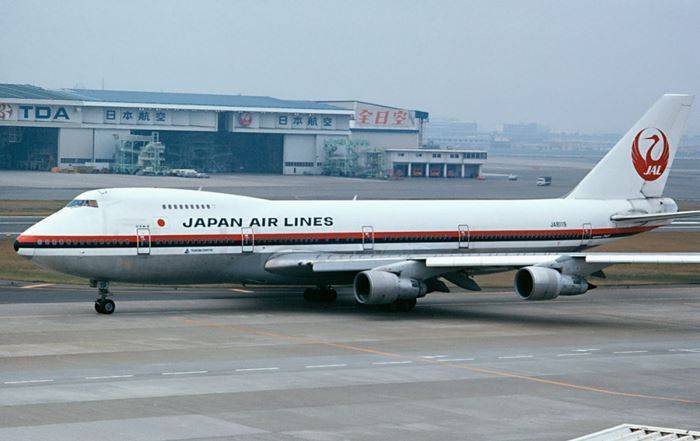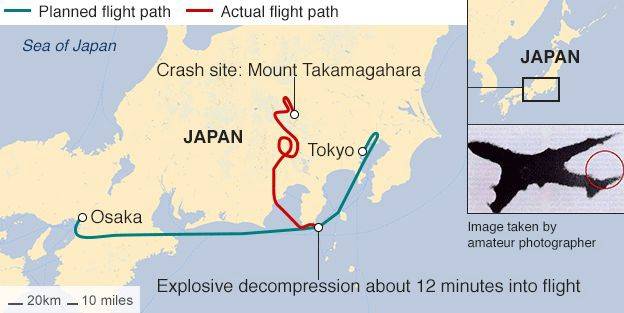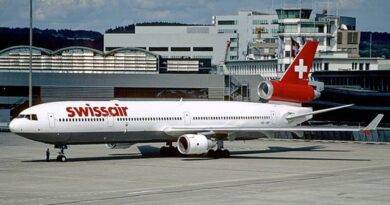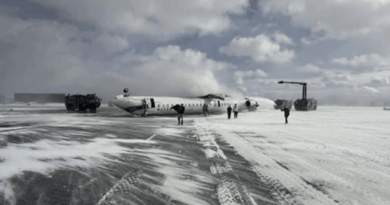Japan Airlines Flight 123 – 12th August 1985
The thing that mainly differentiates airplane accidents from accidents with other vehicles such as cars or trains is that airplane accidents are mostly a lot deadlier than those others. The survival rate of airplane crashes is a lot lower than that of car accidents and other similar accidents. Another important difference is that while there usually happens to be a few casualties in a car accident, if not any, a plane crash can usually cause tens, if not hundreds of people to cease.
The situation for the Japan Airlines Flight 123 crash is also not much different in terms of the number of casualties. During this plane crash that took place on August 12th 1985, a total of 520 people were killed, making this crash the fourth deadliest airplane accident in history, as well as the deadliest single-aircraft accident ever. (By 07.2022)
Generic Information About Japan Airlines Flight 123
Japan Airlines Flight 123 is one of the deadliest aircraft accidents in history, being the cause of death for 520 people, 505 of which were passengers, while the other 15 were flight crew. The airplane that was involved in the accident was a Boeing 747SR-46. The 747SR-46 was a modified version of the classic Boeing 747-100 in response to Japan Airlines’ request. The airplane was modified to be able to carry out domestic flights inside Japan. It was adjusted to be able to carry less fuel and more payload/passengers to increase its capacity in short range.

source: wikipedia
While 520 people were killed during the crash, 4 passengers were able to survive the accident, which is actually very surprising and miraculous for such a deadly airplane crash.
Captain Masami Takahama was in the flight crew as a training instructor for Yutaka Sasaki on the flight, while the flight engineer was Hiroshi Fukuda. Captain Masami Takahama who was at the age of 49 at the time of accident, was a highly experienced captain with over 4800 hours of flight experience with the Boeing 747. On the other hand, Yutaka Sasaki and Hiroshi Fukuda were at the ages of 39 and 46 respectively, and they both also had thousands of hours of flight experience with 747, although they were not as much as that of Takahama’s.
Why And How Did The Crash Happen?
The 747SR-46 took off from Haneda Airport in Ōta at 6.12pm, 12 minutes behind the schedule, on 12th August 1985. There were 524 people on board in total, 509 of which were passengers, while the other 15 were flight crew. After the aircraft took off, around 6.24pm, a rapid decompression (sudden decrease in air pressure inside the airplane, which should ideally be sealed to maintain the healthy air pressure for people onboard) occurred. The decompression caused the ceiling around the rear lavatories to go down. The decompression damaged the unpressurized fuselage aft of the plane, unseating the vertical stabilizers and damaging all of the four hydraulic lines.
As soon as Captain Takahama realized the situation, he requested an emergency return to Haneda Airport. The Tokyo Area Control Center approved the request, and cleared emergency landing at Haneda Airport for the 747SR-46. However, the hydraulic lines of the airplane were severely damaged, and it was reported that the hydraulic pressure was rapidly going down.
Soon after, the captain completely lost control of the aircraft, and was unable to land the 747SR-46 at Haneda Airport. With hydraulic pressure completely lost, the aircraft was now going up and down uncontrollably.
The aircraft was rapidly losing altitude, and the pilots were trying the only thing that they could do to control the plane, which was thrusting the engines on various volumes to stabilize the aircraft. However, there was no hope for the 747SR-46 at this point, and the aircraft crashed on the northwest of Mount Mikuni at 6.56pm, 44 minutes after the takeoff.
During the flight at 6:24 PM
The JAL 123 plane took off from Tokyo Airport. reached a flight altitude of 24,000 feet. At exactly 18:24, two explosions were heard behind the plane. JAL 123 aircraft began to shake with the sounds of explosions heard. After this concussion, passengers were having difficulty breathing due to reduced oxygen. Meanwhile, the pilots were trying to control the plane and the captain pilot declared an emergency.
6:27 p.m.
The JAL123 pilot communicated with the Air Traffic Control Tower. The controller advised the pilots to land at the airport, 115 km from their current location. However, the pilots thought that it was impossible to advance even 115 km. That’s why the pilots requested to land on a longer runway of Haneda Airport. But at this time a problem occurred. As the JAL 123 plane was planning to land, it began to rise uncontrollably.
6.33 pm
The JAL 123 plane soared above 20,000 feet, making it harder for passengers to breathe. The pilots were trying to lower the altitude to reduce cabin pressure. Meanwhile, air traffic controllers noticed something interesting. JAL 123 aircraft started to turn 360 degrees for 3 minutes.
The Situation Is Completely Hopeless
At 6:47 p.m., the JAL 123 aircraft descended uncontrollably to 7,000 feet. But since the plane was close to the mountainous regions, this descent posed the risk of an accident. Because the JAL 123 plane was located in the mountainous region northwest of Tokyo. Then the JAL 123 aircraft began to ascend unexpectedly to 13,400 feet. The pilots tried to control the plane again, but the plane made a sudden descent and crashed into Osaka Mountain at 6:56 p.m.

source: Admiral Cloudberg
Unfortunately, the rescue operation couldn’t be carried out early enough, and the first search-and-rescue unit, which was a C-130 that belonged to the U.S. military, was only able to reach the crash site 20 minutes after the accident. Although multiple search-and-rescue helicopters were quickly sent to the crash site, it was too late for almost all the people onboard, except for only four passengers.


